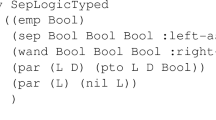Abstract
We describe our progress building the program ReductionFinder, which uses off-the-shelf SAT solvers together with the Cmodels system to automatically search for reductions between decision problems described in logic.
Access this chapter
Tax calculation will be finalised at checkout
Purchases are for personal use only
Preview
Unable to display preview. Download preview PDF.
Similar content being viewed by others
References
Allender, E., Bauland, M., Immerman, N., Schnoor, H., Vollmer, H.: The Complexity of Satisfiability Problems: Refining Schaefer’s Theorem. J. Comput. Sys. Sci. 75, 245–254 (2009)
Ben-Eliyahu, R., Dechter, R.: Propositional semantics for disjunctive logic programs. Annals of Mathematics and Artificial Intelligence 12, 53–87 (1996)
Clark, K.: Negation as Failure. In: Gallaire, H., Minker, J. (eds.) Logic and Data Bases, pp. 293–322. Plenum Press, New York
Cook, S.: The Complexity of Theorem Proving Procedures. In: Proc. Third Annual ACM STOC Symp., pp. 151–158 (1971)
Ebbinghaus, H.-D., Flum, J.: Finite Model Theory, 2nd edn. Springer, Heidelberg (1999)
Eén, N., Sörensson, N.: An Extensible SAT-solver [extended version 1.2]. In: Giunchiglia, E., Tacchella, A. (eds.) SAT 2003. LNCS, vol. 2919, pp. 502–518. Springer, Heidelberg (2004)
Feder, T., Vardi, M.: The Computational Structure of Monotone Monadic SNP and Constraint Satisfaction: A Study Through Datalog and Group Theory. SAIM J. Comput. 28, 57–104 (1999)
Giunchiglia, E., Lierler, Y., Maratea, M.: SAT-Based Answer Set Programming. In: Proc. AAAI, pp. 61–66 (2004)
Hartmanis, J., Immerman, N., Mahaney, S.: One-Way Log Tape Reductions. In: IEEE Found. of Comp. Sci. Symp., pp. 65–72 (1978)
Immerman, N.: Descriptive Complexity. Springer Graduate Texts in Computer Science, New York (1999)
Immerman, N.: Languages That Capture Complexity Classes. SIAM J. Comput. 16(4), 760–778 (1987)
Janhunen, T.: A counter-based approach to translating normal logic programs into sets of clauses. In: Proc. ASP 2003 Workshop, pp. 166–180 (2003)
Jones, N.: Reducibility Among Combinatorial Problems in Log n Space. In: Proc. Seventh Annual Princeton Conf. Info. Sci. and Systems, pp. 547–551 (1973)
Karp, R.: Reducibility Among Combinatorial Problems. In: Miller, R.E., Thatcher, J.W. (eds.) Complexity of Computations, pp. 85–104. Plenum Press, New York (1972)
Ladner, R.: On the Structure of Polynomial Time Reducibility. J. Assoc. Comput. Mach. 2(1), 155–171 (1975)
Libkin, L.: Elements of Finite Model Theory. Springer, Heidelberg (2004)
Lifschitz, V., Razborov, A.A.: Why are there so many loop formulas? ACM Trans. Comput. Log. 7(2), 261–268 (2006)
Moskewicz, M.W., Madigan, C.F., Zhao, Y., Zhang, L., Malike, S.: Chaff: Engineering an Efficient SAT Solver. In: Design Automation Conference 2001 (2001)
Reingold, O.: Undirected ST-connectivity in Log-Space. In: ACM Symp. Theory of Comput., pp. 376–385 (2005)
Schaefer, T.: The Complexity of Satisfiability Problems. In: ACM Symp. Theory of Comput., pp. 216–226 (1978)
Schwartz, J.T., Dewar, R.B.K., Dubinsky, E., Schonberg, E.: Programming with Sets: an Introduction to SETL. Springer, New York (1986)
Valiant, L.: Reducibility By Algebraic Projections. L’Enseignement mathématique, T. XXVIII 3-4, 253–268 (1982)
Author information
Authors and Affiliations
Editor information
Editors and Affiliations
Rights and permissions
Copyright information
© 2010 Springer-Verlag Berlin Heidelberg
About this chapter
Cite this chapter
Crouch, M., Immerman, N., Moss, J.E.B. (2010). Finding Reductions Automatically. In: Blass, A., Dershowitz, N., Reisig, W. (eds) Fields of Logic and Computation. Lecture Notes in Computer Science, vol 6300. Springer, Berlin, Heidelberg. https://doi.org/10.1007/978-3-642-15025-8_10
Download citation
DOI: https://doi.org/10.1007/978-3-642-15025-8_10
Publisher Name: Springer, Berlin, Heidelberg
Print ISBN: 978-3-642-15024-1
Online ISBN: 978-3-642-15025-8
eBook Packages: Computer ScienceComputer Science (R0)




